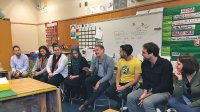Community Walks Create Bonds of Understanding
When students lead teachers through their communities, the cultural exchange can have a transformational effect on school culture.
Your content has been saved!
Go to My Saved Content.Community walks are one of my favorite ways to break down barriers between schools and families. These walking experiences allow educators to learn about students in their communities and on their terms. What are the most important places and landmarks in their neighborhoods? Who are the formal and informal leaders? A walk might include a house of worship, a community center or nonprofit, and a meal at a local restaurant or a student’s home. Students create an itinerary, organize a teach-in, and host an experiential learning session for their teachers.
I recently attended a community walk at Oakland International High School (OIHS) in California, which serves newly arrived immigrants from 33 countries who speak 32 languages. This walk focused on unaccompanied minors from Central America—students who immigrated without papers or the presence of a legal guardian. We listened to students tell their immigration stories, interviewed a panel of support providers, and walked the Fruitvale neighborhood, where many students live. We ended our day at Centro Legal de la Raza, talking with a legal advocate about the impact of recent changes to immigration law. It was illuminating.
Why Do Community Walks?
Oakland International has been doing community walks with all of its major language and cultural groups for several years. According to principal Carmelita Reyes, the result is nothing short of transformational. She tells a story about two Yemeni boys who got into a fight at school, which none of their friends intervened to stop. Reyes called the local imam, or spiritual leader, who had participated in the Yemeni community walk.
The imam came to campus within hours to facilitate a restorative circle—a structured dialogue that allows participants to listen, express themselves, and repair interpersonal harm—with the eight boys involved. According to Reyes, the group discussed “what had happened and what needed to happen in the future to maintain a safe school community.” The discussion, she says, was “bigger than the fight—it was about the collapse of supportive culture.” After the circle, there were no further incidents.
Gerardo, an unaccompanied minor from El Salvador, describes the purpose of community walks in this way: “People from another country can tell their story and can tell how difficult it is to get to the United States.… It’s a way to make American people and people who immigrate come together.” Reyes points out that walks instill cultural pride in students: “‘Hey, teachers think our community is important!’ There is a real sense of validation.”
Community Walks: An Action Plan
At OIHS, walks are built into the professional development calendar for a full afternoon each fall. A few weeks prior, teachers rank their preferences for which community they would like to learn about based on the students in their classes and the cultural groups they feel less knowledgeable about. The week prior, Reyes and her community school manager, Lauren Markham, scaffold the experience in two ways: They preview each itinerary and then facilitate reading circles in which teachers learn more about the specific immigrant community they will be visiting. Students and families often weigh in on the readings that will be presented.
On the day of the walk, students lead a teach-in with their staff group, sharing a PowerPoint presentation about their country of origin and their immigration experiences. For the walk I attended, the students had prepared a full lesson plan with a journal assignment and a turn-and-talk prompt.
Here are a few additional steps, with guiding questions, to help you implement this transformative routine:
- Set a clear purpose. Why has our school or team chosen to do community walks? Which community do we hope to learn more about?
- Craft a learning question. Can you clearly state what you wonder about or hope to learn from this experience?
- Create norms to promote respect. Have you and your staff discussed how to model respect as you enter the community? Have you created norms to guide faculty behavior?
- Invite students, families, and the community to participate. Have you asked parents and students to identify the most important places for teachers to visit and learn about? Have you coached students to design an engaging experience? Have you organized a meeting with leaders from the community you will visit?
- Structure the experience. Have you created time during the workday for staff to participate? Have you built in time (at least an hour) for a thorough debrief of the experience? Have you planned a reflection process for staff to share key learnings?
